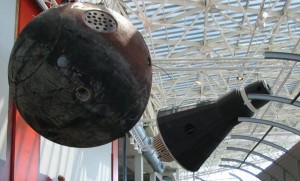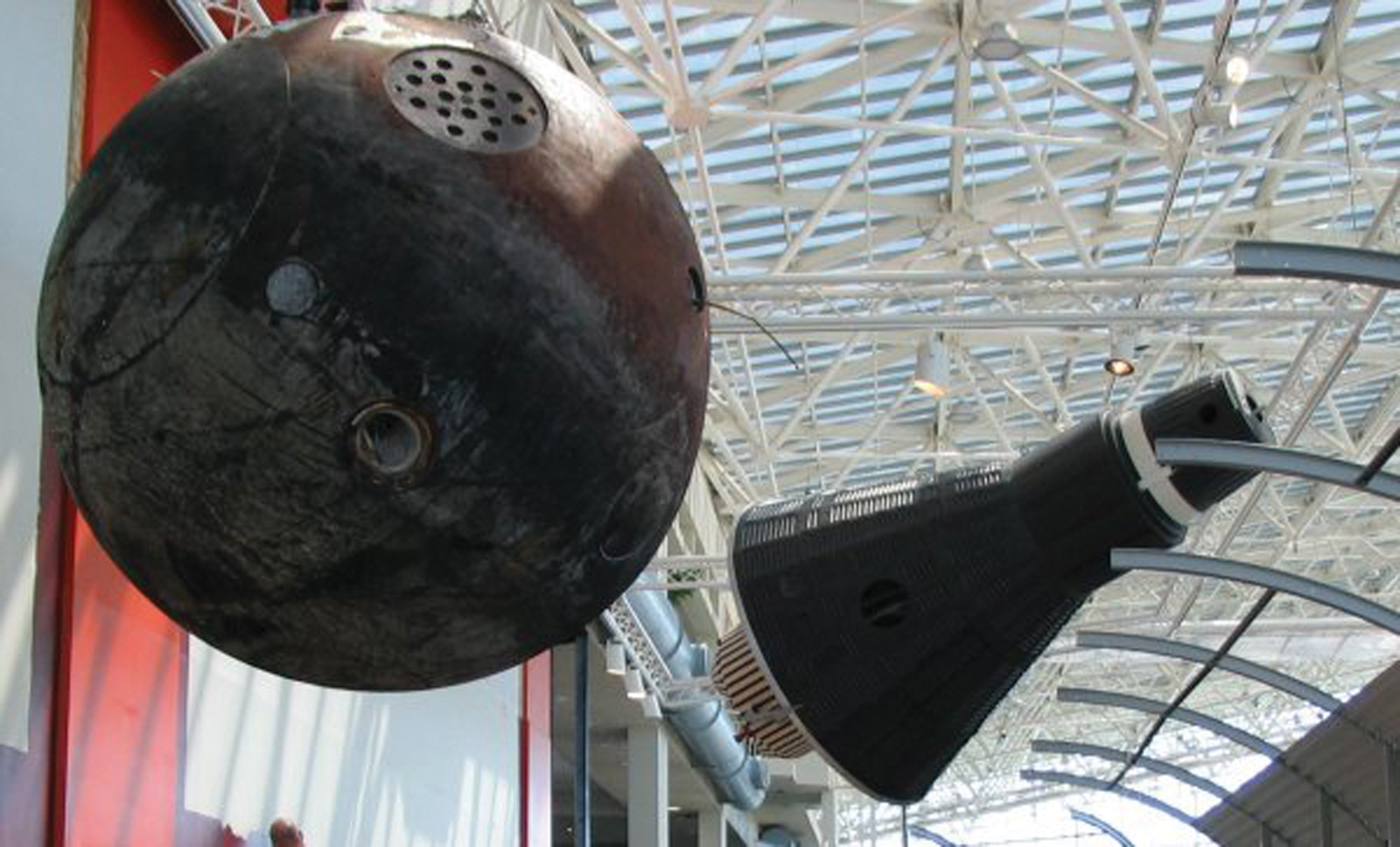
Full-scale replicas of Russia’s Sputnik I, a NASA Mercury space capsule and a real Russian space capsule that traveled into space are part of The Museum of Flight’s space exploration exhibit.
By Terry Stephens
A new exhibit at Seattle’s Museum of Flight, “Space: Exploring the New Frontier,” celebrates 50 years of space exploration, beginning with Russia’s launch of Sputnik I. The 6,000-square-foot array of galleries and exhibits salutes astronauts, space stations, moonwalks and other space events that changed the course of human history.
As the first manmade object to orbit Earth, on Oct. 4, 1957, Sputnik I caught the world’s attention. Russia’s beeping sphere, less than 23 inches in diameter, was the catalyst for accelerating America’s own space program. The surprise of Russia’s satellite success led to creating the National Aeronautics and Space Agency, launching a space race between the United States and Russia, and the development of an astronaut program that put Americans on the moon first.
One of the most important but less celebrated events from those years, however, was the creation of the National Defense Education Act of 1958. The legislation provided federal education funds for students and universities to help increase the ranks of America’s graduates in science, mathematics and engineering. One of those graduates was NASA astronaut Dr. Bonnie Dunbar. When she was a girl, the sight of a bright speck crossing the night sky inspired her interest in science and space flight.
“We had very clear nights in eastern Washington and very few planes, except for some going into Yakima, so it was a really big deal when Sputnik I was launched and we saw it one night,” said Dunbar, who is now president and CEO of the Museum of Flight. “I’ve been interested in space flight and science from those early times.”
After graduating from the University of Washington and working for Boeing Computer Services, Harwell Laboratories in Oxford, England, and Rockwell International’s Space Division, she joined NASA in 1978.
“NASA took us to the moon in 1969, put us permanently into Earth orbit with the International Space Station, gave us the unforgettable images of the Hubble Space Telescope and put small robots on Mars,” she said recently, while commenting about the importance of the museum’s new space exhibit. “The NDEA gave us a generation of scientists, engineers and teachers who provided us with the tools for technological leadership and new visions for the future. Sputnik I was a small satellite, but it changed lives and history forever.”
The anniversary of Sputnik I’s launching provided a focal point for the museum to emphasize the importance of the space program over the past five decades. The exhibit includes space-age artifacts and walk-through reproductions, starting with “The Birth of Rocketry.” Scenes from old books that told of travel to distant planets are displayed near a replica of Dr. Robert Goddard’s first successful liquid-fueled rocket, constructed and tested in 1926.
The next section, “Sputnik and the Space Race,” examines the years of competition between the United States and Russia to venture into outer space. Overhead are replicas of Sputnik I, a 1961 Mercury capsule used at the start of the astronaut program and an actual 1992 Russian Resurs 500 space capsule that was flown in space. Pop culture reflections of the time are shown on video screens throughout the exhibit, including television shows, commercials and news broadcasts from that period.
A walk-though of a full-size replica of the International Space Station Destiny’s laboratory is a highlight of this section. Memorabilia from space science legend Carl Sagan, moon rocks from the Apollo 17 mission and a simulated demonstration of how astronauts landed a lunar module and a space shuttle are also included.
The museum also displays a 1996 Sojourner Mars Rover, built as a backup to the two Rovers that successfully landed on and conducted explorations of the Red Planet. There’s also the restored Apollo Command Module 007, used by astronauts to practice ocean landings made on early flights prior to developing the space shuttle fleet.
Finally, the huge exhibit explores future space travel, including the budding age of space tourism. Overhead hangs a replica of SpaceShipOne. Designed by Burt Rutan, the suborbital rocket plane blasted into history on Oct. 4, 2004, becoming the first private manned spacecraft to exceed an altitude of 328,000 feet twice within the span of a 14-day period, thus claiming the $10 million Ansari X-Prize.
The space exhibit also features a 26-foot-long moonscape panorama from the Apollo 17 mission, created by Moonpans.com, which wraps around displays of a lunar rover and lunar landing module.
Visitors have the opportunity to use simulators to land a space shuttle at the Kennedy Space Center, as well as touch down a lunar module on the surface of Earth’s moon and explore its cratered surface. A life-size model of NASA’s Mission Control Center in Houston explains how astronaut missions are carried out. Wrapping up the exhibit is a look at future return trips to the moon and the potential of manned flights to the surface of Mars.
For more information, visit [http://www.museumofflight.org].











